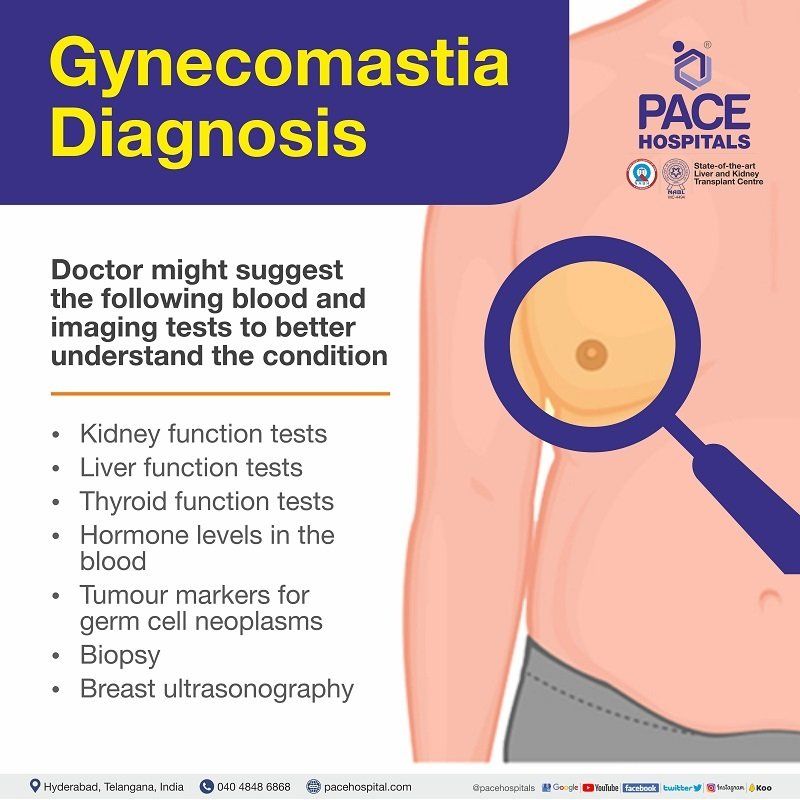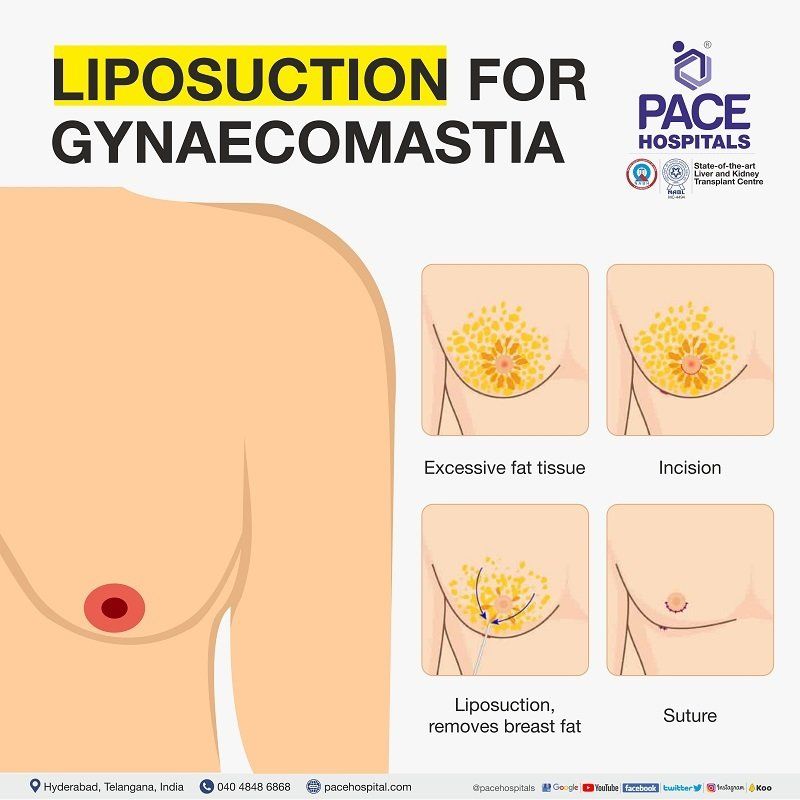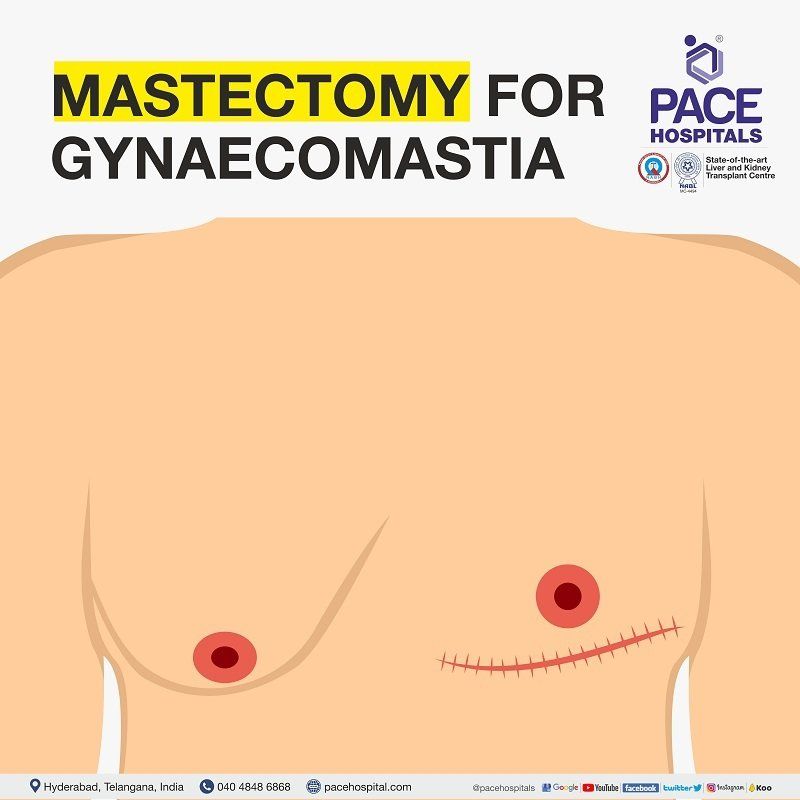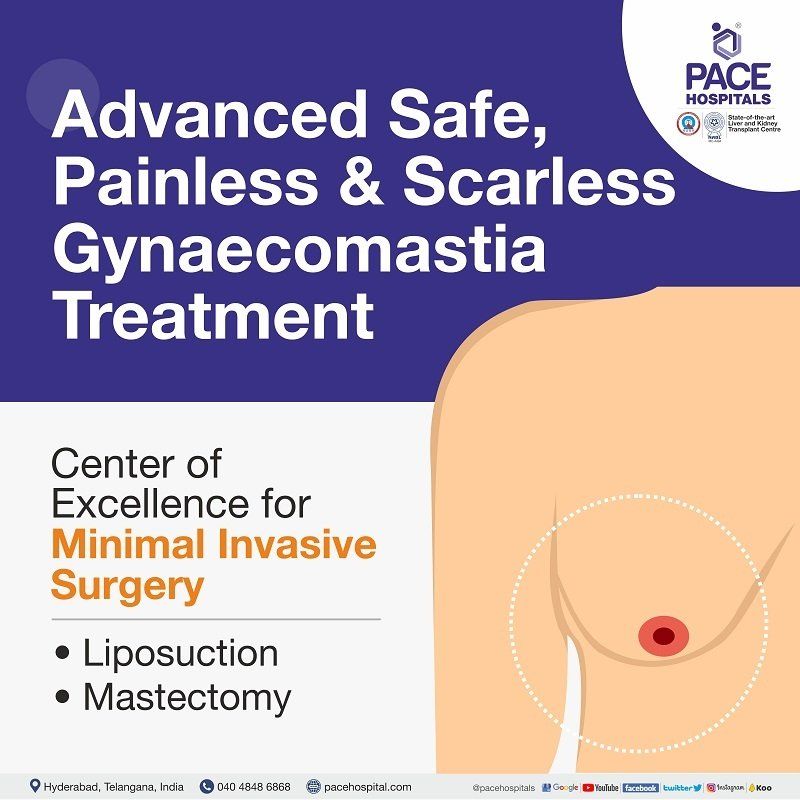Gynecomastia Treatment in Hyderabad, Surgery and Cost
At PACE Hospitals, team of gynecomastia doctors – highly qualified and experienced plastic and reconstructive surgeon, aesthetic surgeon are experienced in performing aesthetic plastic surgery, male breast reduction surgery for gynecomastia. The treatment options available are:
- Liposuction (male breast fat tissue removal)
- Mastectomy (male glandular breast tissue removal)
Get Rid of Gynecomastia, Request an appointment.
Gynaecomastia Treatment - appointment
Diagnosis of Gynecomastia
The diagnosis of gynaecomastia is primarily based on physical examination (symptoms). You will be in a supine (lying) position, where your doctor will examine you for firmness (presence of glandular mass) by performing a gynecomastia pinch test (squeezing the breast between the examiner's thumb and forefinger) on the area starting from the outer regions of the breast to the centre (nipple).

During a physical exam, gynaecomastia is diagnosed when the area under the areolar (coloured area around the nipple) breast tissue is 2 cm or bigger. Further, your doctor might suggest the following blood and imaging tests to better understand the condition.
Kidney function tests: This test is used to assess how efficiently your kidneys are working (removing waste from your body). Blood and urine sample are required for this test. Any abnormality in this test might indicate the underlying condition of gynaecomastia.
Liver function tests: This test is used to measure various enzymes and proteins of the liver through a blood sample. It includes albumin, total protein, alkaline phosphatase, alanine transaminase, aspartate aminotransferase, gamma-glutamyl transferase, bilirubin, prothrombin time and lactate dehydrogenase. Your doctor might suggest this test to check for any liver abnormalities. If you have liver disease, you will have an:
- Increase in androstenedione production from the adrenal glands,
- Increase in the conversion of androstenedione to oestrone and oestrone to oestradiol.
- Decrease in the clearance of adrenal androgens from the liver.
- Increase in sex hormone binding globulin.
These factors result in a decrease in free testosterone levels in the blood. This causes an imbalance between oestradiol and testosterone concentration, which is one of the reasons for the gynaecomastia condition.
Thyroid function tests: This test is used to measure thyroid (T3 and T4) hormone, T3 resin uptake, and thyroid stimulating hormone levels in the blood. The increase in T4 and T3 levels and low thyroid stimulating hormone leads to hyperthyroidism.
Due to the presence of hyperthyroidism, there will be an increase in blood luteinizing hormone concentration, which leads to an increase in oestradiol levels and testosterone production from Leydig cells (primary source of testosterone or androgens in males). In addition to this, sex hormone binding globulin will be increased. As a result, it will increase the oestradiol concentration, which causes the imbalance between the oestradiol and testosterone concertation.
Hormone levels in the blood:
- Serum levels of testosterone hormone (total and bioavailable), luteinizing hormone, follicle-stimulating hormone and prolactin hormone. Abnormal concentrations of these hormones might result in a decrease in testosterone levels.
- Oestrogen (oestradiol) hormone levels in the blood: An increase in oestrogen concentration can result in an imbalance between oestradiol and testosterone concertation, which is the primary cause of gynaecomastia.
- Levels of adrenal androgens: An increase in adrenal androgens like serum dehydroepiandrosterone sulphate leads to an increase in oestradiol concentration. This causes an imbalance between oestradiol and testosterone concentration, which is the root cause of gynaecomastia.
Tumour markers for germ cell neoplasms: The presence of tumour markers such as beta human chorionic gonadotropin suggests the presence of germ cell neoplasm, which can be used to diagnose testicular cancer. Men with testicular cancer have low testosterone levels.
Biopsy: a procedure where a small amount of breast tissue is taken and examined for the presence of cancer cells. This test is conducted in order to differentiate whether you have gynaecomastia or breast cancer.
Mammogram: A low-dose X-ray of your breast, called a mammogram, may be done to check for the presence of dense breast tissue with dendritic and nodular features. The presence of such a mass diagnosis the condition of gynaecomastia.
Breast ultrasonography:
This test is done in order to access the presence of hypoechoic mass (a tissue which is more dense or solid than usual) under the areolar region (the region of dark-coloured skin that surrounds the nipple). The presence of such a mass signifies the presence of gynaecomastia.
Advanced Centre for Gynecomastia Surgery with State-of-the-art Laser Technology
PACE Hospitals is one of the Advanced and Experienced Gynecomastia Treatment Hospital in Hyderabad backed up with the best plastic and reconstructive surgery doctors, aesthetic surgery doctors, nursing, and paramedical staff. Department of Plastic and Reconstructive Surgery, Cosmetic Surgery at Pace Hospitals equipped with state-of-the-art facility and latest laser ablation technology offering comprehensive treatment for breast enlargement in men.

Liposuction (male breast fat tissue removal)
It is a surgical procedure where excess fat is removed from a specific area of the body with the help of suction. Under local or general anaesthesia (based on the patient's profile), the patient was marked at the area of incision before surgery. After anaesthesia is administered, the liposuction process will be started by making very small incisions in the targeted area. The number of incisions needed is determined by the amount of fat deposited. The surgeon inserts a thin tube called a cannula into the incision. The inserted cannula will undergo continuous back and forth in a guided movement, to dislodge the fat cells. The dislodged fat is then sucked out through a surgical vacuum. Post that, the surgeon closes the incision with absorbable sutures (stiches) and firmly bands the area. You may be asked to wear compression garment for one month. Some surgeons might use advanced techniques like ultrasound and laser to minimise invasiveness.

Mastectomy (male glandular breast tissue removal)
Mastectomy is a surgical procedure used to treat the patient when there is a requirement for the removal of glandular breast tissue or excess skin in order to correct gynaecomastia conditions. Under general anaesthesia, the excess fat and glandular tissue will be removed through an incision (above, beneath, or to the side of the nipple). The open area is then closed with sutures (stiches). You may be asked to wear compression garment for one month.
Frequently asked questions:
Why does cirrhosis cause gynaecomastia?
If you are suffering from liver cirrhosis:
- There will be an increase in the production of hormone from the adrenal glands.
- A decrease in the clearance of adrenal androgens from the liver, and increased hormone binding globulin lead to a decrease in free testosterone levels in the blood.
Thus, the decrease in testosterone levels leads to gynaecomastia (man boobs or enlarged male breast tissue).
Can testosterone cure gynaecomastia?
Yes, with the help of testosterone replacement therapy, it can be resolved. This therapy helps in maintaining testosterone and oestrogen ratios in the blood, thereby reducing gynaecomastia (male breast development) condition.
How to figure out if its gynaecomastia?
Check the area behind or surrounding the nipple (either of one or both). If you find any soft rubbery lump or if you have any pain in that particular area consult your physician immediately. If there is nothing such, then it is a pseudogynaecomastia which occurred due to excess body fat storage, otherwise your physician will be diagnosing based on physical examination, or might request for following tests for more clarity.
- Breast ultrasonography and mammography.
- Assessment of underlying conditions such as renal (kidney), thyroid and liver disease, testicular cancer, tumours of the adrenal glands or pituitary gland.
Read more: Gynecomastia Symptoms and Causes
Can carbohydrates increase gynaecomastia?
No, carbohydrates are essential sources for testosterone production, which could help in the maintenance of the testosterone to oestrogen concentration ratio through which gynaecomastia can be prevented.
Does ADHD treatment cause gynaecomastia?
The use of drugs is a significant contributor to the development of gynecomastia. Certain drugs like centrally acting sympathomimetic which are commonly preferred for treating attention deficit hyperactivity disorder (ADHD) in children and adolescents might have gynaecomastia as uncommon side effect.
How long to see final result of gynaecomastia surgery?
You can see the results immediately post-surgery. The incision marks which appear during the surgery will be fading out in a while and the final results may take 3-6 months to achieve.
Can we delay surgery for gynaecomastia?
In most cases, gynaecomastia in males resolves on its own and doesn’t require any surgery. However, delay in surgery for gynaecomastia could result in minimal risk of developing male breast cancer.
How long should I wear compression garment after gynaecomastia surgery?
The compression garment should be worn all day for four to six weeks, even when you sleep (can remove while on bath) to have a better outcome. It acts as a layer to protect your healing incision. It improves circulation and reduces pain.
How to Get rid of Gynaecomastia Naturally?
In general, gynaecomastia does not require any treatment as it self- subsides within in a period of time (6 months to 2 years). Stopping certain medications which cause gynaecomastia, can also help in resolving the gynaecomastia condition.
It might require treatment if it is caused by any underlying diseases such as hypogonadism, starvation, liver cirrhosis, etc and hormonal imbalance.
How much does a gynaecomastia surgery cost?
The average cost of gynaecomastia surgery in India is approximately 72,000 (Rupees seventy-two thousand only). However, male breast reduction surgery or gynaecomastia surgery cost in India, ranges vary from Rs. 62,000 to Rs. 1,36,500 (Rupees sixty-two thousand to one lakh thirty-six thousand five hundred) depends on severity or grade of male breast enlargement, the different private hospitals in different cities.
What is gynecomastia surgery cost in Hyderabad?
Gynecomastia surgery cost in Hyderabad ranges vary from Rs. 45,000 to Rs. 1,25,000 (Rupees forty-five thousand to one lakh twenty-five thousands). However, cost of gynecomastia surgery or male breast reduction surgery depends upon the multiple factors such as grade and severity of enlarged male breasts, the amount of fat to be removed, techniques such as liposuction or mastectomy performed, risk associated with the surgery, room selection for hospital stay, corporate or insurance approvals for cashless facility.






